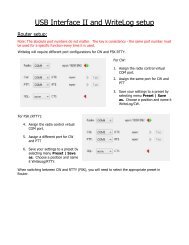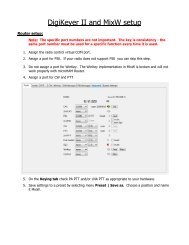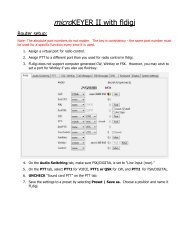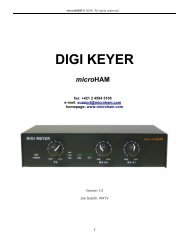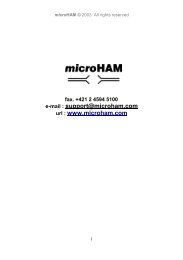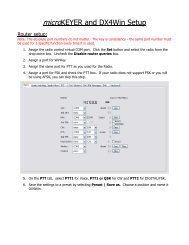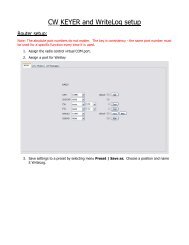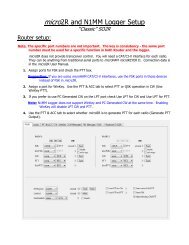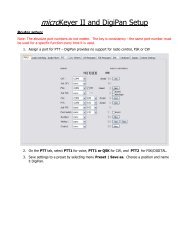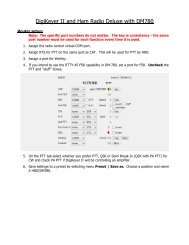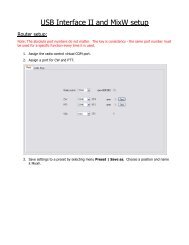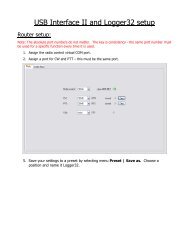DIGI KEYER II - microHAM
DIGI KEYER II - microHAM
DIGI KEYER II - microHAM
Create successful ePaper yourself
Turn your PDF publications into a flip-book with our unique Google optimized e-Paper software.
<strong>microHAM</strong> © 2010 All rights reservedCAT PORT & 2 nd CAT PORTThe CAT channel is used by application software to control transceiver frequency, mode, T/R switching andmany other parameters using a serial (CAT) protocol. Most modern radios implement some form of CAT butalmost every radio implementation is different. The functions controlled by the computer depend on theparticular application and radio.NOTE: The port number assigned in Router MUST match the port number assigned in the hostapplication. First configure the virtual COM ports in Router then configure the application.When a COM port is assigned in the Router but notin the application (or the application is not running)Router will indicate the channel is closed.When an application opens the COM port assigned for control (usually at start-up), Router shows thechannel as open and displays baud rate, data bits, parity and number of stop bits used by the application.For example, 4800 8N2 means: 4800 baud, 8 bits data length, parity = none, and two stop bits.Data flowing through the CAT channel is indicated by two arrows. A green arrow indicates data flow from theapplication to the radio and a red arrow indicates data flow from the radio to the application.TIP: If the application provides for PTT (T/R) keying by radio control (CAT) turn this function OFF.PTT by CAT is not reliable because RFI can prevent the radio from switching back to receive. Thereis a dedicated T/R switching channel for this purpose called PTT.NOTE: If your radio does not support handshake (most do not). Configure DTR and RTS settingsin your application program (logger) for Always On or Always Off. Do not select “Handshake.”For Router to determine the operating frequencyand mode, it must know what radio (CAT protocol)being used. To select the radio, click the Setbutton, choose your radio in the Radio combo box,select communication speed in the Baud rate box,and set the CI-V address for Icom and someTenTec radios.TIP: Disable the Autobaud function in any Icom Radio used with Router. Configure the radio,Router, and your application software to operate at 9600 or 19200 baud.Disable router queries – When this box checked, Router will not poll the radio for frequency and modewhen that information is not available from the communication between the application and radio.NOTE: "Disable router queries" disables Router polling only when the port has been openedby an application program. When the virtual port is closed, Router always polls the radio tosupport the automatic switching functions of <strong>DIGI</strong> <strong>KEYER</strong> <strong>II</strong>. If it is necessary to disable allpolling, select one of the "none" options in the Radio box.WARNING: DO NOT select "Disable Router queries" unless you have a specific reason to do so. Routeronly polls for information that is not requested by the logger and does not interfere with logger polling.Disabling Router queries may result in incorrect frequency and/or mode decoding and can have a seriousimpact on overall operation.19



